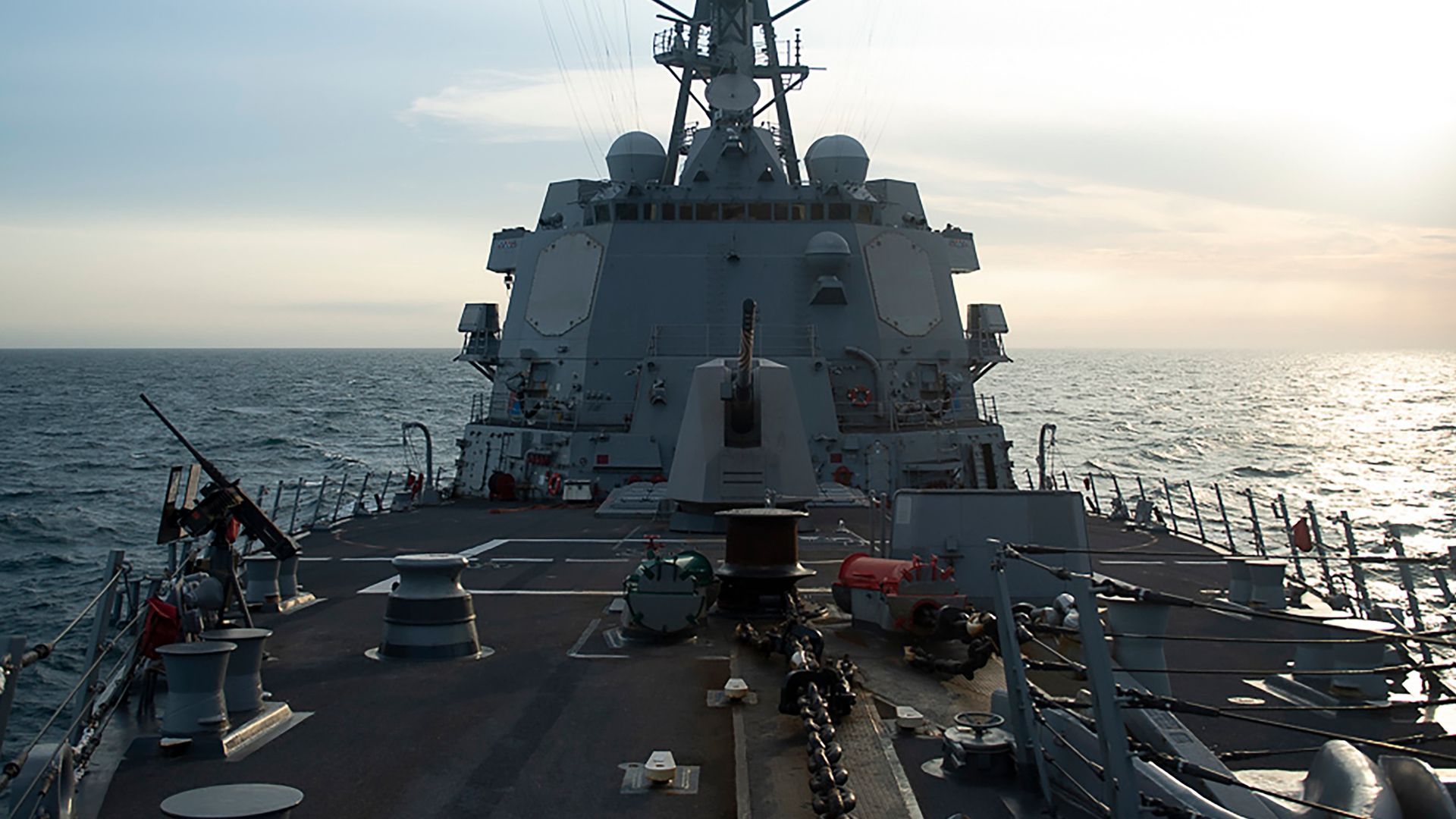
[Ryan Robertson]
IT’S BUDGET PLANNING TIME IN WASHINGTON, WHICH MEANS IT’S TIME FOR THE PENTAGON TO SUBMIT ITS REQUEST FOR MONEY FROM THE AMERICAN TAXPAYERS.
FOR FISCAL YEAR 2025, THE PENTAGON IS ASKING FOR A PAULTRY $849.5 BILLION. THAT’S ONLY ABOUT 1% MORE THAN IT REQUESTED LAST YEAR, THOUGH, WHICH DOESN’T KEEP UP WITH INFLATION.
NOW, I’M GOING TO GO THROUGH HOW EACH SERVICE BRANCH PLANS TO SPEND ITS SHARE OF THE FUNDS, BUT BEFORE I DO I WANT TO REMIND EVERYONE CONGRESS STILL HASN’T APPROVED LAST YEAR’S BUDGET REQUEST FROM THE PENTAGON. INSTEAD, THE DOD IS STILL OPERATING ON A CONTINUING RESOLUTION WHICH IMPACTS A WHOLE HOST OF BUDGETARY ISSUES. ALSO, IN ORDER TO KEEP THE GOVERNMENT FROM SHUTTING DOWN LAST FALL, CONGRESS AND PRESIDENT BIDEN AGREED TO THE FISCAL RESPONSIBILITY ACT WHICH SET A HARD CAP ON DEFENSE SPENDING IN FISCAL YEAR 2025. SO, SOME PLANS THAT WERE IN THE WORKS FOR YEARS ARE NOW DELAYED.
ALL THAT TOGETHER MEANS EVERY DOLLAR AMOUNT WE TALK ABOUT HERE IS AN ESTIMATE AND IS SUBJECT TO CHANGE SOMEWHAT DEPENDING ON HOW LONG IT TAKES CONGRESS TO ACT AND WHAT LEVEL OF FUNDING IT DEEMS APPROPRIATE.
CLEAR AS MUD? OKAY, LET’S BEGIN.
SO, AS A WHOLE THE DOD’S NEARLY $850 BILLION BUDGET INCLUDES A 4.5% PAY RAISE FOR SERVICE MEMBERS, MORE FUNDING FOR CHILD DEVELOPMENT CENTERS AND ON BASE FACILITIES, AND MORE MONEY FOR SERVICE MEMBERS TO APPLY TOWARDS THEIR BASIC HOUSING ALLOWANCE. ALL GOOD THINGS.
AS FAR AS INDIVIDUAL BRANCHES GO, LET’S START WITH THE DEPARTMENT OF THE NAVY, WHICH ACTUALLY OVERSEES BOTH THE NAVY AND MARINE CORPS.
THE NAVY IS REQUESTING ABOUT $204 BILLION IN FUNDING. THE MARINES JUST UNDER $54 BILLION.
THAT REPRESENTS A TOTAL BUDGET INCREASE OF UNDER 1%. SO, THE NAVY, LIKE EVERY SERVICE BRANCH, SAID IT HAD TO MAKE SOME HARD CHOICES. THE NAVY PREVIOUSLY SAID IT WOULD STOP BUYING F/A-18 SUPER HORNETS SO IT COULD SAVE FUNDS FOR THE NEXT GENERATION AIR DOMINANCE FIGHTER BEING DEVELOPED IN COORDINATION WITH THE AIR FORCE. BUT THE NAVY SAYS THE BILLION DOLLARS IN FY25’S BUDGET THAT WAS MEANT FOR THE NGAD PROGRAM WILL NOW HAVE TO BE REALLOCATED.
THE NAVY SAYS BUDGET CONSTRAINTS ALSO MEAN IT NEEDS TO DIVEST OF 10 SHIPS OR RETIRE THEM EARLY; SOMETHING CONGRESS HATES TO DO ESPECIALLY NOW THAT CHINA HAS THE WORLD’S LARGEST FLEET, BY NUMBER OF SHIPS AT LEAST.
BUT THE NAVY SAYS IT COULD SAVE A LOT OF MONEY IF IT DIDN’T HAVE TO KEEP UP WITH THOSE 10 SHIPS. MONEY THAT COULD BE USED TO HELP BUY THE 6 NEW VESSELS THE NAVY WANTS; A LIST WHICH INCLUDES A NEW VIRGINIA-CLASS SUBMARINE, A COUPLE OF ARLEIGH BURKE CLASS DESTROYERS, AND THE MARINE CORPS’ FIRST MEDIUM LANDING SHIP.
THE MARINE CORPS IS ALSO REQUESTING FUNDING FOR ITS HELICOPTER FLEET.
BUT LIKE THE NAVY AND THE NGAD, THE MARINES ARE ALSO DELAYING SPENDING ON SOME UNMANNED PROGRAMS IN FAVOR OF MAINTAINING READINESS.
STAYING ON THE WATER, AND OF ALL THE U.S. SERVICE BRANCHES, THE U.S. COAST GUARD IS REQUESTING THE SMALLEST CHUNK OF CHANGE FROM CONGRESS. JUST $13.8 BILLION, WHICH IS ACTUALLY LESS THAN LAST YEAR TOO. THE COAST GUARD SAID THE MONEY WILL BE USED TO BUY SEVERAL NEW CUTTERS AND PAY FOR UPGRADES TO ITS MH-60 HELICOPTER FLEET.
MAKING OUR WAY ONTO LAND NOW, WHERE A LARGE PORTION OF THE ARMY’S $186 BILLION REQUEST WILL GO TOWARDS PERSONNEL COSTS, AS WELL AS OPERATIONS AND MAINTENANCE. THE ARMY IS THE LARGEST AND OLDEST OF ALL THE BRANCHES, EMPLOYING MORE THAN 442,000 ACTIVE DUTY SOLDIERS PLUS ANOTHER 325,000 NATIONAL GUARDSMEN AND 175,000 RESERVISTS.
THE ARMY ALREADY AXED ITS FUTURE ATTACK RECONNAISSANCE AIRCRAFT PROGRAM, AND WITH THE ADDED BUDGET CONSTRAINTS ANNOUNCED THE EXTENDED RANGE CANNON ARTILLERY PROGRAM IS NOW ALSO DEAD. ALTHOUGH, SOME OF THE WORK BEING DONE ON THE MUNITIONS FOR THAT WILL CONTINUE.
THE ARMY’S BUDGET REQUESTS OF COURSE INCLUDES MONEY FOR MORE MUNITIONS, INCLUDING THE NEW PRECISION STRIKE MISSILE WHICH IS REPLACING THE ATACMS. THE ARMY IS ALSO SETTING ASIDE FUNDS FOR THE NEW INTEGRATED VISUAL AUGMENTATION SYSTEM. IT’S A BATTLEFIELD GOGGLE DISPLAY FOR FOOT SOLDIERS THAT HAS BEEN IN DEVELOPMENT FOR YEARS. IF THE NEXT ROUND OF TESTING GOES WELL, THE ARMY WANTS TO BUY MORE THAN 3000 UNITS IN FY25.
SO, NOW THAT WE’VE COVERED THE EARTH-BOUND SERVICE BRANCHES, LET’S TALK ABOUT THE DEPARTMENT OF THE AIR FORCE, WHICH INCLUDES BOTH THE AIR AND SPACE FORCES.
THE AIR FORCE IS REQUESTING $188 BILLION DOLLARS. SPACE FORCE $29 BILLION.
WITH THE MONEY, THE USAF SAYS IT CAN PROCURE 90 NEW AIRCRAFT INCLUDING 42 F-35s, 18 F-15EXs, MORE THAN A DOZEN TANKERS, SOME HELICOPTERS AND A HANDFUL OF THE NEW T-7A RED HAWK TRAINERS.
HOWEVER, THE AIR FORCE ALSO WANTS TO DIVEST OF 250 AIRCRAFT INCLUDING 32 F-22s, 26 F-15Es…AND A WHOPPING 56 A-10 WARTHOGS.
IN TERMS OF MUNITIONS, THE AIR FORCE WANTS TO BUY A SLEW OF LONG-RANGE MISSILES AND ANTI-SHIP WEAPONS. BUT, SOMEWHAT SURPRISINGLY, THERE IS NO MONEY SET ASIDE FOR LOCKHEED MARTIN’S ARRW HYPERSONIC MISSILE.
THE SPACE FORCE IS THE SMALLEST OF THE BRANCHES, BUT ITS MISSION IS ABSOLUTELY VITAL TO ALL OF THEM SINCE PRETTY MUCH EVERYTHING DEPENDS ON SPACE-BASED COMMUNICATION NOW. TO THAT END, THE SPACE FORCE WANTS TO SPEND THE BULK OF ITS BUDGET BEEFING UP THE SATELLITES IT PUTS INTO SPACE BY MAKING THEM MORE RESILIENT. THE SPACE FORCE WANTS TO INCREASE ITS NUMBER OF SATELLITES AS WELL. THE SERVICE WANTS TO FUND AT LEAST 11 LAUNCHES IN FY25 AND PUTS A LARGE CHUNK OF ITS REQUESTED BUDGET TOWARD MORE RESEARCH, DEVELOPMENT, TEST AND EVALUATION ACTIVITIES.
LIKE I SAID AT THE BEGINNING OF THIS STORY, ALL OF THESE NUMBERS AND FIGURES ARE SUBJECT TO CHANGE BECAUSE A LOT OF FY25’S SPENDING DEPENDS ON FY24’S BUDGET, WHICH AGAIN, CONGRESS HAS BEEN SITTING ON SINCE LAST YEAR.
ALSO, IN ADDITION TO PAYING FOR ALL OF ITS REGULAR BILLS THE PENTAGON IS FOOTING THE TAB ON SOME BORDER SECURITY OPERATIONS AND SOME SUPPLIES SENT OVER TO UKRAINE. THOSE THINGS ARE SUPPOSED TO BE PAID FOR BY THE SUPPLEMENTAL FUNDING BILL THAT CONGRESS IS ALSO STILL SITTING ON. SO, IN THE MEANTIME, THOSE COSTS ARE BEING COVERED OUT OF SOME SERVICES’ CORE BUDGETS, WHICH MEANS THERE’S EVEN LESS MONEY TO GO AROUND.







